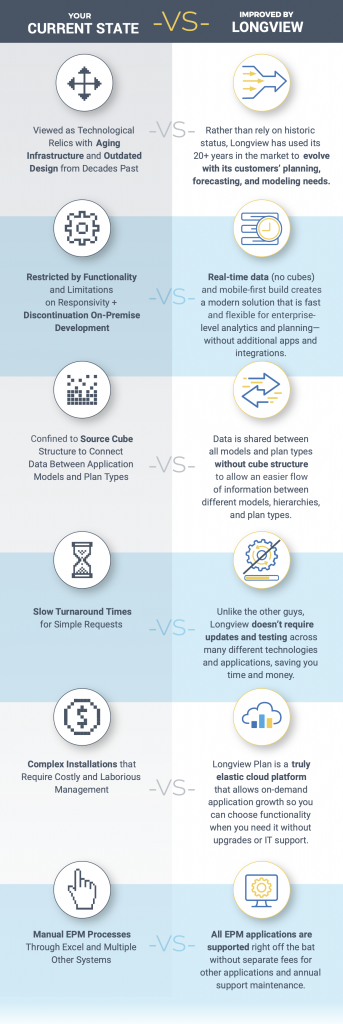Common Problems With CPM Software

When it comes to optimizing business performance, there’s quite a bit of jargon that gets thrown around. Corporate performance management (CPM) is one example, and it’s often used interchangeably with business performance management and enterprise performance management.
However, these terms tend to encompass the same concept: the collection of methods and processes designed to maximize the performance of an organization. And an entire industry of software solutions has cropped up to help companies achieve this. Let’s take a closer look at what corporate performance management is, why it’s important, and the common problems presented by many CPM software solutions.
What Is Corporate Performance Management?
CPM is a broad term that describes the processes put in place to manage the success of an organization. CPM is a subset of the even broader concept of business intelligence (BI).
BI is the collection of technologies, applications, and practices that allow a company to analyze incoming business data and produce useful, strategic insights. CPM is not a strategy itself. Rather, it represents the management framework put in place by corporate leadership to monitor and respond to important metrics.
Once isolated within the finance department, CPM is now broadly employed in the form of reporting departmental metrics measured against targets. If done well, CPM enables an organization to boost its performance and drive growth.
CPM shouldn’t be confused with employee performance management. Sometimes referred to as human performance management, this subset of human resources works to improve the productivity and satisfaction of employees. Employee performance management relies on metrics such as personal performance reviews and turnover rates.
In contrast, CPM isn’t involved with the performance of employees on the individual level. Instead, it deals with how to communicate and execute your business strategy, usually by establishing specific performance metrics and standardized processes to evaluate and promote performance across the company.
CPM is an evolving concept. The term originated with Gartner, the global research and advisory firm, back in 2001. But a great deal has changed since then, including massive developments in technology as well as workplace culture. The concepts of CPM are still widely applicable, though new terms such as financial planning and analysis and financial close—which encompass specific CPM processes—are now sometimes used in CPM’s place.
Why Focus on CPM?
Strategy execution is quickly becoming one of the most important areas of concern for senior executives. This is especially true for businesses seeking to:
- Upgrade financial planning processes
- Reduce costs
- Improve key performance indicators (KPIs)
- Restructure their budget
- Reconfigure their overall strategy
CPM helps integrate organizational planning, finance, marketing, sales, and human resources around the same strategic priorities, directly linking departmental goals with company-wide goals. This alignment of your company’s operations ensures that key business strategies progress from theory on paper to action on the ground.
CPM is usually centered around several important management processes, including:
- Identifying goals and KPIs and formulating a business strategy
- Budgeting, planning, and forecasting in finance
- Frequent financial consolidation and closing the books
- Updating internal and external stakeholders on results
- Monitoring key metrics
- Renewing goals or strategies based on results and incoming forecasts
The functions of CPM are essential to the C-suite and the long-term success of a company. As a result, some organizations are dedicating entire departments to strategy and performance management. An office of strategy management takes on the major tasks of strategic planning, including tracking key metrics.
CPM metrics aren’t as simple as tracking revenue. They encompass every facet of an organization, including:
- Financial metrics: every key financial performance number, from sales to losses
- Customer metrics: customer-centric indicators, such as retention and satisfaction rates
- Compliance metrics: transparency, consistency, and reliability metrics that help businesses adhere to regulations from different agencies
- Internal metrics: input from internal stakeholders that can bring insight and help evaluate the success of CPM strategies
CPM Software: The Solution for CPM
Some organizations may choose to dedicate a department to their strategic planning activities. However, a more common solution is to delegate responsibility for corporate performance across the executive leadership team.
This can be facilitated through the adoption of a CPM software solution. Typically used within finance departments, CPM software monitors and manages financial and operational performance within a business.
Advanced CPM software solutions offer what seems like the holy grail of corporate performance management—a single integrated platform that can handle all key performance management processes, including:
- Budgeting
- Planning
- Forecasting
- Scenario modeling
- Financial and regulatory reporting
- Variance analysis
- Financial consolidation and close management
- Tax provisioning
- Intercompany transactions
Common CPM Software Problems
CPM software represents a straightforward approach to streamlining your performance management processes. But problems can arise as the scope of the software platform expands. Here are some of the most common CPM software problems that hamper businesses.
Implementation
The problem? Implementing new software—especially software that covers as many processes as a full-service CPM solution—comes with its own unique challenges. A common worry is that company productivity will take a hit while you go through a lengthy implementation process. And inadequate training tools and a lack of support from the software vendor can exacerbate the issue.
The solution? Implementation doesn’t need to be a nightmare. The key to successful implementation is to have a plan and establish strong communication between your vendor and project teams early in the process. It’s also helpful to choose a vendor who understands the importance of a smooth transition. insightsoftware combines a proven knowledge transfer process and 24/7 customer technical support to get you up and running quickly.
Ease of Use
The problem? It’s one thing to get new CPM software up and running across your organization. It’s another thing to convince all of your employees to actually use it. Overly complicated, clunky platforms that aren’t user-friendly can cause adoption rates to plummet. Employees will abandon the new software in favor of their old, familiar processes. Why pay for software that nobody’s going to use?
The solution? Vet any potential CPM software for usability. When CPM software is easy to use, your employees will embrace the new solution and never look back. Customer retention is a good indication of how satisfied companies are with a particular CPM solution.
Flexibility
The problem? Although CPM software can help improve many key performance management processes, adapting software solutions for your company’s needs can sometimes feel like trying to fit a square peg into a round hole. Every organization is unique, with its own distinct set of goals and challenges. Unfortunately, some CPM software programs try to act like one-size-fits-all solutions, and often end up fitting no one.
The solution? Make sure any CPM platform you choose has built-in flexibility so you can customize outputs such as management dashboards and financial reports for the unique needs of your company.
Connecting Finance with the Rest of Your Organization
The problem? Not all CPM software is created equal. A common weakness is business integration—a piece of software may contain baseline functionality while failing to completely integrate your financial management with operations, human resources, and the rest of your organization.
The solution? Many CPM processes fall under the purview of finance, but a solid CPM software platform will connect data from your entire organization with finance. With all data integrated into a single centralized but multidimensional cloud database, it’s easier to perform comprehensive analysis, find trends, and help your company’s leadership make better decisions.
Empower Your Organization to Maximize Performance
Essential to the C-suite, CPM represents the framework that aligns your organization’s goals with its planning, allowing for effective strategy execution. By avoiding the most common pitfalls and choosing the right CPM software solution, you can help your organization streamline all of its planning processes and maximize performance.
Tidemark offers a flexible CPM platform that will engage your teams, shorten your planning cycle, and save valuable time. But what makes Tidemark different from other CPM solutions? A lower cost, fewer headaches, less IT involvement, and more strategic planning.
Request a Demo of Tidemark Today
Request Now
